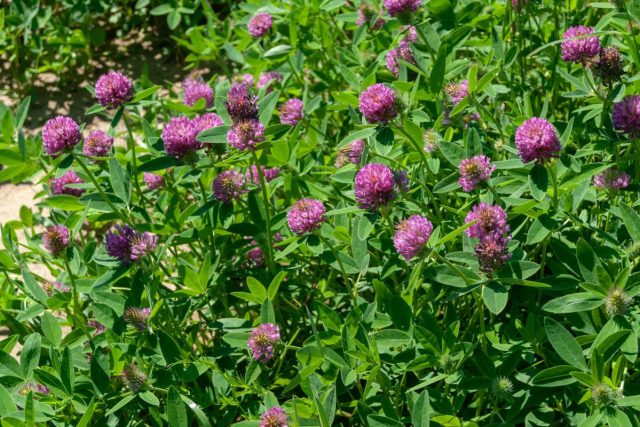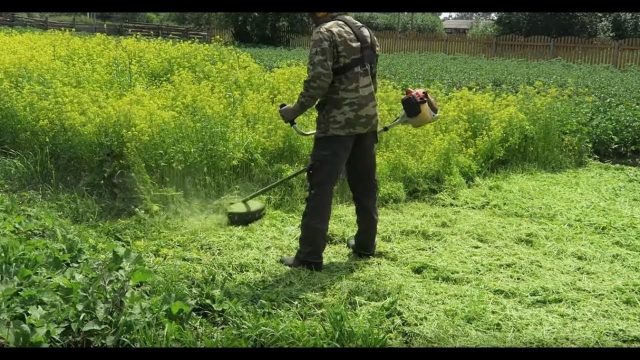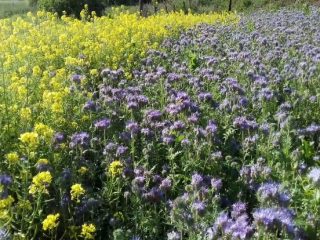Content
Green manure plants are a worthy alternative to mineral fertilizers: they simultaneously saturate the substrate with useful substances and improve its quality. However, they will show their best only if you study in advance the nuances of the planting procedure (including the optimal timing) and mowing the greenery. Green manure can be sown in summer, early spring or closer to autumn: each time has its own, most suitable crops.
Benefits of summer planting
In addition to traditional spring and autumn planting, green manure can also be sown in summer. Gardeners choose this period taking into account the following advantages of the procedure:
- Green manure creates a continuous green carpet in the garden bed. If you sow them in the summer, it creates protection from drying out and weathering, which is especially necessary for the soil in hot weather.
- Plant roots actively loosen the soil in the garden bed. If you sow green manure in the summer, this favorable state of the substrate for garden crops will definitely remain until next spring.
- The rapid growth of greenery prevents the appearance of weeds in the landscaped area. Accordingly, you can save time and effort on preparing this bed for other crops if you sow them in the summer.
- This is an effective express means for restoring soil after the main crop.If you harvest early enough, before mid-summer, there will be enough time to sow green manure and ensure soil fertility for the next season.

Summer green manures are chosen so that they do not end up adjacent to cultivated plants from the same family
Which green manures are best to sow in summer?
Based on their belonging to a specific family, green manures are divided into several groups. Most of them can be sown in summer: rapid growth rates and the formation of voluminous green mass are characteristic of almost all crops.
Rape
Rapeseed is a herbaceous annual plant of the Brassica family. A plant of short daylight hours, very frost-resistant. In agriculture, rapeseed is in demand not only as green manure. It is a valuable honey plant and raw material for the production of livestock feed with a high protein content.
Due to the presence of extremely long (up to 3 m) roots, rapeseed is indispensable for loosening and restoring the airiness of the soil, drawing out nutrients from its deep layers. In addition, if sown in summer, it effectively prevents weathering and overdrying of the substrate.
The essential oils released by rapeseed disinfect the soil, destroying pathogenic microflora, and drive away many pests from plantings. It is also recommended to sow it in summer to limit the growth of weeds. In particular, rapeseed successfully displaces wheatgrass from the beds.

Rapeseed green manure is a mandatory stage of crop rotation when introducing energy-saving technologies in agriculture
Mustard
Mustard is a herbaceous annual of the Brassica family.It looks very nice, if you sow it in the summer, it will not only be green manure, but also decorate the site. In principle, mustard is suitable for planting throughout most of the season.
In summer, it is recommended to sow mustard in beds with potatoes, tomatoes, eggplants, and other Solanaceae. It provides their roots with protection from overheating, effectively smothers weeds, and most importantly, destroys the causative agents of late blight and scab. It is also suitable for these crops as a predecessor.
Mustard roots actively loosen the substrate. It is especially useful for areas prone to alkalization. If you sow it in the summer as green manure, this will protect the beds from slugs, wireworms, and codling moths.

Mustard can be sown not only in summer, but also in early spring: this is proven by the high (up to -6 ° C) cold resistance of green manure
Lupine
Lupine is a herbaceous shrub of the Legume family. Like other relatives, it is distinguished by the presence of symbiont bacteria living in special nodules on its roots, which extend approximately 2 m into the soil. They absorb nitrogen in the deep layers of the soil and bring it closer to the surface. In addition, lupine, if planted in the summer as green manure, transfers phosphorus from soil that is indigestible for plants into one that is easily digestible.
Lupine effectively loosens the soil and normalizes its pH in case of high acidity. It is also extremely useful for light soils. Its greens must be mowed and embedded in the ground before the stems become coarse.

Lupine seeds do not have good germination; before sowing them as green manure, it is recommended to carry out scarification
Phacelia
Herbaceous annual plant of the Aquifolia family. Almost universal green manure, a good honey plant. Phacelia can be sown in all beds in the summer; after it, any vegetables, berries, and herbs will feel good. The plant is decorative, cold- and drought-resistant. It successfully takes root both on heavy and very poor soils, even on rocky soils.
If you sow phacelia as green manure in the summer, it will quickly begin to release phytoncides into the soil, which effectively destroy pathogens of various types of rot, scab, and late blight. In addition, its essential oils successfully drive away aphids, nematodes, wireworms, and codling moths from plantings.
Phacelia has a very fast growth rate. Budding occurs within 4-6 weeks after emergence.

The versatility of phacelia as a green manure is due to the fact that it is not related to garden crops; it can be sown in any bed
Oilseed radish
A fodder vegetable crop of the Cruciferous family that forms root crops. It is cold-resistant; seedlings appear just 5-8 days after sowing.
The main advantages of oilseed radish as green manure are its ability to take root in almost any soil and its rapidly growing root system, which effectively displaces any weeds from the garden bed. In addition, its above-ground part, if sown in summer, actively releases essential oils into the air, which successfully inhibit pathogenic microflora and repel pests (wireworms, nematodes).
The crop is practically indestructible: oilseed radish successfully adapts to drought, cold, and high humidity in summer. It is highly recommended to sow it to protect the soil from wind and water erosion.

Oilseed radish, if sown in summer, forms green mass more slowly than other green manures - in 10-12 weeks
Clover
Herbaceous plant of the Legume family, a good honey plant. In summer, both white (creeping) and red (meadow) clover can be sown as green manure. Like its relatives, it actively saturates the soil with nitrogen. The roots are fibrous, developed, and successfully loosen the substrate and displace weeds.
Compared to other green manures, clover is more demanding on soil quality - it prefers a moderately moist substrate with a neutral or close to it pH. In summer, this is not the best green manure for sandy soils.
It takes 8-10 weeks for clover to form green mass. Unlike most green manure, it is mowed during the flowering period. However, the only procedure will not give a pronounced effect: clover must be grown on the site for at least two years, mowing periodically.

If you sow clover as green manure in the summer, it needs to be provided with regular watering; the soil should not dry out
How to plant green manure in summer
There are several places where you can sow green manure in the summer:
- Vacant areas. Green manure will quickly prepare the soil for cultivated plants, increasing its fertility and enriching its composition.
- Vacant beds. Many early-ripening and ultra-early varieties and hybrids are harvested already in mid-summer. If you immediately sow green manure, there will be enough time for them to sprout and form green mass.
- Row spacing. A method that not only improves soil quality.Green manure, if sown in summer, releases essential oils and other substances into the soil and air that drive away pests from the beds and destroy pathogens.
- In tree trunks. In this case, green manure is both a decorative element and mulch. When the gardener does not have the opportunity to permanently live on the site, you can sow green manure to increase the intervals between waterings.
Accordingly, green manure can be sown throughout the summer - both simultaneously with the main crops and after them. Planting several times per season is also acceptable.

Seed consumption is always quite large: otherwise it is impossible to ensure the required density of the green carpet
The procedure is standard in all cases. Before sowing green manure, the area is dug up or at least loosened in the summer if possible. During the process, complex fertilizers containing nitrogen, phosphorus and potassium (5-7 g/m²) are applied. The only exception is legumes.
Seeds are sown scattered, just from a handful. The absence of grooves ensures the necessary planting density. After green manure is sown, the bed is harrowed or simply covered with earth. In some crops, seeds germinate slowly in the light and germination rate decreases.
Mowing and finishing
Green manure, if sown in summer, is mowed at the same stage of development as when planted at other times - in the phase of mass budding. Ripe greens are cut as close to the soil as possible and immediately embedded in the soil to a depth of 10-15 cm. On light sandy soils it is more convenient to use a hoe or a flat cutter, on heavy clay soils - with a shovel or cultivator.

During budding, green manure gains maximum green mass
Some gardeners prefer to sow green manure in the summer and simply mow them without burying them in the ground.They motivate this by the fact that in the process, beneficial microflora and fauna die, and the natural structure of the soil is disrupted. The greens are simply laid out on the surface of the beds and sprinkled with a thin layer of humus or other mulch. It quickly begins to decompose, saturating the soil with nitrogen, and eventually turns into humus with the help of earthworms and microorganisms.

There is no need to plant the greenery too deeply; it should be in the layer of the most fertile topsoil
Conclusion
If green manure is sown in summer, it is possible to provide garden crops that will grow in this area next season with one of the basic conditions for development - soil fertility, its saturation with macro- and microelements. Therefore, they can be considered as a complement or even a replacement for traditional fertilizers. There are quite a lot of green manures suitable for sowing in the summer; they require minimal care: mowing the greenery will take the most time and effort from the gardener.








